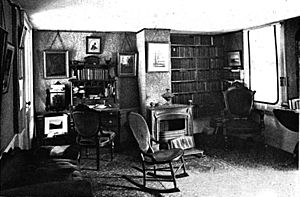John Greenleaf Whittier House facts for kids
|
John Greenleaf Whittier Home
|
|

John Greenleaf Whittier Home, Amesbury, Massachusetts
|
|
| Location | 86 Friend St., Amesbury, Massachusetts |
|---|---|
| Built | 1811 |
| NRHP reference No. | 66000792 |
Quick facts for kids Significant dates |
|
| Added to NRHP | October 15, 1966 |
| Designated NHL | December 29, 1962 |
The John Greenleaf Whittier Home is a special old house located in Amesbury, Massachusetts. It was the home of a famous American poet and abolitionist named John Greenleaf Whittier. He lived here from 1836 until he passed away in 1892. Today, it is a museum that you can visit. It is open to the public from May 1st through October 31st, and there is a small fee to enter. This house is very important, so it was named a National Historic Landmark in 1962. It was also added to the National Register of Historic Places in 1966.
Contents
A Poet's Home: History
The John Greenleaf Whittier House was built in 1811. Back then, it was a small, one-and-a-half-story wooden house. It had four rooms on the main floor and one room in the attic. A kitchen area and a small shed were added to the back.
Whittier bought this house in 1836. He wanted a place for himself, his mother, his aunt, and his sister Eliza to live. He stayed in this house until he died in 1892. Whittier wrote most of his famous poems and stories right here. This includes his well-known poem, Snow-Bound, which he wrote in the Garden Room.
Changes to the House Over Time
The Whittier family made many changes to the house during the 80 years they owned it. Whittier added a new bedroom to the house soon after he bought it. In 1847, with help from a kind person named Joseph Sturge, the house became much bigger. The new bedroom was made larger and turned into a sitting room and study. A porch was added to the east side of the house. Also, a full second story was built over the eastern half of the house.
Preserving Whittier's Legacy
After Whittier died in 1892, his niece, Lizzy Pickard, was not able to take care of the house. So, in 1898, the Whittier Home Association was created. This group wanted to save the house and remember Whittier's life. Lizzy's son, Greenleaf Pickard, decided to live in the house in 1904. He made some additions to help protect the original parts that Whittier used.
The west side of the house was also raised to a full two stories. The old kitchen area was replaced with a new two-story addition. The front porch you see today likely dates from this time too. The old kitchen area was moved away from the house and is now a small separate building.
The Whittier Home Association later bought the house. They opened it as a museum. The house and its furniture are mostly the same as they were when the poet died. You can see the living rooms, bedroom, and Whittier's writing study, all with his original furnishings.
Whittier's birthplace is in nearby Haverhill. That house, called the John Greenleaf Whittier Homestead, is also open for people to visit.
See also




